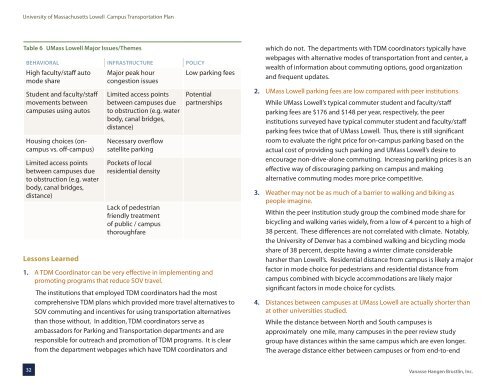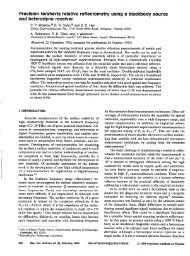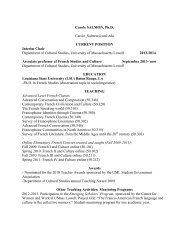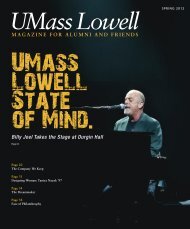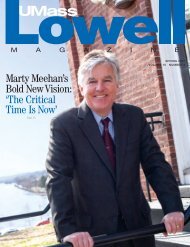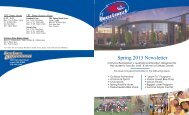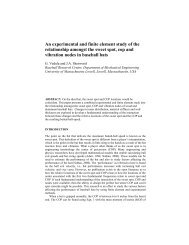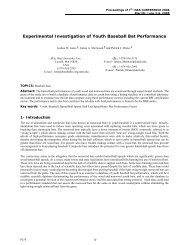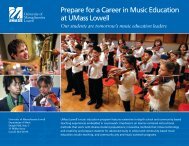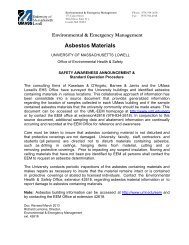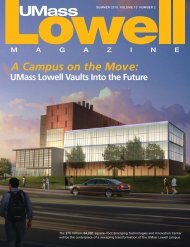comprehensive campus transportation plan - University of ...
comprehensive campus transportation plan - University of ...
comprehensive campus transportation plan - University of ...
Create successful ePaper yourself
Turn your PDF publications into a flip-book with our unique Google optimized e-Paper software.
<strong>University</strong> <strong>of</strong> Massachusetts Lowell Campus Transportation Plan<br />
Table 6 UMass Lowell Major Issues/Themes<br />
BEHAVIORAL INFRASTRUCTURE POLICY<br />
High faculty/staff auto<br />
mode share<br />
Student and faculty/staff<br />
movements between<br />
<strong>campus</strong>es using autos<br />
Housing choices (on<strong>campus</strong><br />
vs. <strong>of</strong>f-<strong>campus</strong>)<br />
Limited access points<br />
between <strong>campus</strong>es due<br />
to obstruction (e.g. water<br />
body, canal bridges,<br />
distance)<br />
Lessons Learned<br />
Major peak hour<br />
congestion issues<br />
Limited access points<br />
between <strong>campus</strong>es due<br />
to obstruction (e.g. water<br />
body, canal bridges,<br />
distance)<br />
Necessary overflow<br />
satellite parking<br />
Pockets <strong>of</strong> local<br />
residential density<br />
Lack <strong>of</strong> pedestrian<br />
friendly treatment<br />
<strong>of</strong> public / <strong>campus</strong><br />
thoroughfare<br />
Low parking fees<br />
Potential<br />
partnerships<br />
1. A TDM Coordinator can be very effective in implementing and<br />
promoting programs that reduce SOV travel.<br />
The institutions that employed TDM coordinators had the most<br />
<strong>comprehensive</strong> TDM <strong>plan</strong>s which provided more travel alternatives to<br />
SOV commuting and incentives for using <strong>transportation</strong> alternatives<br />
than those without. In addition, TDM coordinators serve as<br />
ambassadors for Parking and Transportation departments and are<br />
responsible for outreach and promotion <strong>of</strong> TDM programs. It is clear<br />
from the department webpages which have TDM coordinators and<br />
which do not. The departments with TDM coordinators typically have<br />
webpages with alternative modes <strong>of</strong> <strong>transportation</strong> front and center, a<br />
wealth <strong>of</strong> information about commuting options, good organization<br />
and frequent updates.<br />
2. UMass Lowell parking fees are low compared with peer institutions.<br />
While UMass Lowell’s typical commuter student and faculty/staff<br />
parking fees are $176 and $148 per year, respectively, the peer<br />
institutions surveyed have typical commuter student and faculty/staff<br />
parking fees twice that <strong>of</strong> UMass Lowell. Thus, there is still significant<br />
room to evaluate the right price for on-<strong>campus</strong> parking based on the<br />
actual cost <strong>of</strong> providing such parking and UMass Lowell’s desire to<br />
encourage non-drive-alone commuting. Increasing parking prices is an<br />
effective way <strong>of</strong> discouraging parking on <strong>campus</strong> and making<br />
alternative commuting modes more price competitive.<br />
3. Weather may not be as much <strong>of</strong> a barrier to walking and biking as<br />
people imagine.<br />
Within the peer institution study group the combined mode share for<br />
bicycling and walking varies widely, from a low <strong>of</strong> 4 percent to a high <strong>of</strong><br />
38 percent. These differences are not correlated with climate. Notably,<br />
the <strong>University</strong> <strong>of</strong> Denver has a combined walking and bicycling mode<br />
share <strong>of</strong> 38 percent, despite having a winter climate considerable<br />
harsher than Lowell’s. Residential distance from <strong>campus</strong> is likely a major<br />
factor in mode choice for pedestrians and residential distance from<br />
<strong>campus</strong> combined with bicycle accommodations are likely major<br />
significant factors in mode choice for cyclists.<br />
4. Distances between <strong>campus</strong>es at UMass Lowell are actually shorter than<br />
at other universities studied.<br />
While the distance between North and South <strong>campus</strong>es is<br />
approximately one mile, many <strong>campus</strong>es in the peer review study<br />
group have distances within the same <strong>campus</strong> which are even longer.<br />
The average distance either between <strong>campus</strong>es or from end-to-end<br />
32<br />
Vanasse Hangen Brustlin, Inc.


